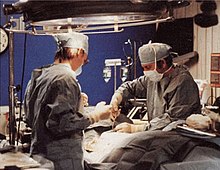
Cryonics (from Greek: κρύος kryos, meaning "cold") is the low-temperature freezing (usually at −196 °C or −320.8 °F or 77.1 K) and storage of human remains in the hope that resurrection may be possible in the future.[1][2] Cryonics is regarded with skepticism by the mainstream scientific community. It is generally viewed as a pseudoscience,[3] and its practice has been characterized as quackery.[4][5]
Cryonics procedures can begin only after the "patients" are clinically and legally dead. Procedures may begin within minutes of death,[6] and use cryoprotectants to try to prevent ice formation during cryopreservation.[7][better source needed] It is not possible to reanimate a corpse that has undergone vitrification, as that damages the brain, including its neural circuits.[8][9] The first corpse to be frozen was that of James Bedford, in 1967.[10] As of 2014, about 250 bodies had been cryopreserved in the United States, and 1,500 people had made arrangements for cryopreservation of their remains.[11]
Economic considerations make it difficult for cryonics corporations to remain in business long enough to take advantage of any long-term benefits.[12] The "patients", being dead, cannot continue to pay for their own preservation. Early attempts at cryonic preservation were made in the 1960s and early 1970s; most relied on family members to pay for the preservation and ended in failure, with all but one of the companies going out of business and the corpses thawed and disposed of.[13] The remaining organization, Alcor, uses a patient care trust to ensure that their preservations can be supported indefinitely.[14]
- ^ McKie, Robin (13 July 2002). "Cold facts about cryonics". The Observer. Archived from the original on 8 July 2017. Retrieved 1 December 2013.
Cryonics, which began in the Sixties, is the freezing – usually in liquid nitrogen – of human beings who have been legally declared dead. The aim of this process is to keep such individuals in a state of refrigerated limbo so that it may become possible in the future to resuscitate them, cure them of the condition that killed them, and then restore them to functioning life in an era when medical science has triumphed over the activities of the Grim Reaper.
- ^ "Dying is the last thing anyone wants to do – so keep cool and carry on". The Guardian. 10 October 2015. Archived from the original on 3 July 2017. Retrieved 21 February 2016.
- ^ Cite error: The named reference
jkwas invoked but never defined (see the help page). - ^ Cite error: The named reference
butlerwas invoked but never defined (see the help page). - ^ Cite error: The named reference
qwas invoked but never defined (see the help page). - ^ Hendry, Robert; Crippen, David (2014). "Brain Failure and Brain Death". ACS Surgery: Principles and Practice critical care. Decker Intellectual Properties Inc. pp. 1–10. Archived from the original on 23 January 2021. Retrieved 3 March 2016.
A physician will pronounce a patient using the usual cardiorespiratory criteria, whereupon the patient is legally dead. Following this pronouncement, the rules pertaining to procedures that can be performed change radically because the individual is no longer a living patient but a corpse. In the initial cryopreservation protocol, the subject is intubated and mechanically ventilated, and a highly efficient mechanical cardiopulmonary resuscitation device reestablishes circulation.
- ^ Best BP (April 2008). "Scientific justification of cryonics practice" (PDF). Rejuvenation Research. 11 (2): 493–503. doi:10.1089/rej.2008.0661. PMC 4733321. PMID 18321197. Archived from the original (PDF) on 21 July 2018. Retrieved 26 December 2013.
- ^ Cite error: The named reference
popsiclewas invoked but never defined (see the help page). - ^ Devlin, Hannah (18 November 2016). "The cryonics dilemma: will deep-frozen bodies be fit for new life?". The Guardian. Archived from the original on 24 January 2019. Retrieved 21 January 2019.
- ^ "Death To Dust: What Happens To Dead Bodies? 2nd Edition, Chapter 7: Souls On Ice". Archived from the original on 27 March 2019. Retrieved 21 March 2016.
- ^ Moen, OM (August 2015). "The case for cryonics". Journal of Medical Ethics. 41 (18): 493–503. doi:10.1136/medethics-2015-102715. PMID 25717141. S2CID 31744039.
- ^ Cite error: The named reference
declinewas invoked but never defined (see the help page). - ^ Cite error: The named reference
hta-lawwas invoked but never defined (see the help page). - ^ "The Alcor Patient Care Trusts". Retrieved 18 September 2024.